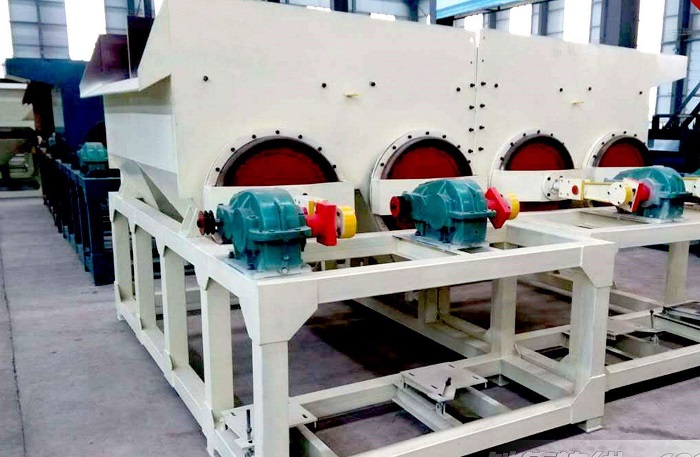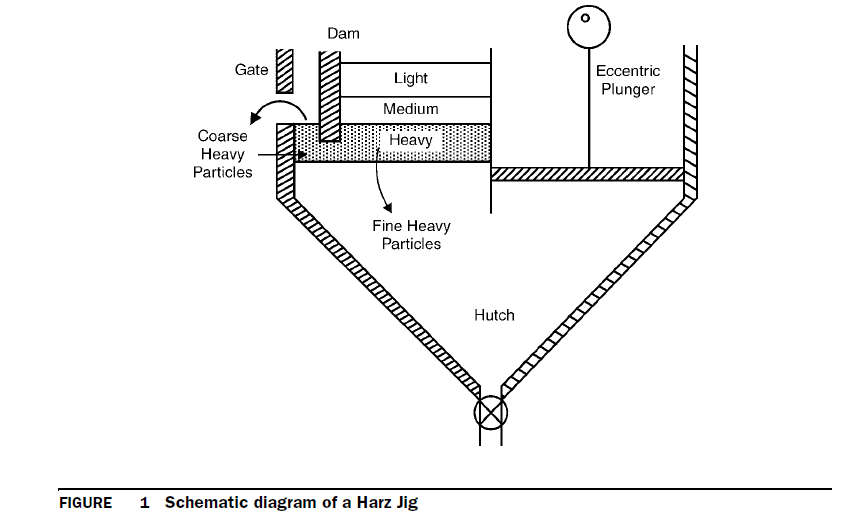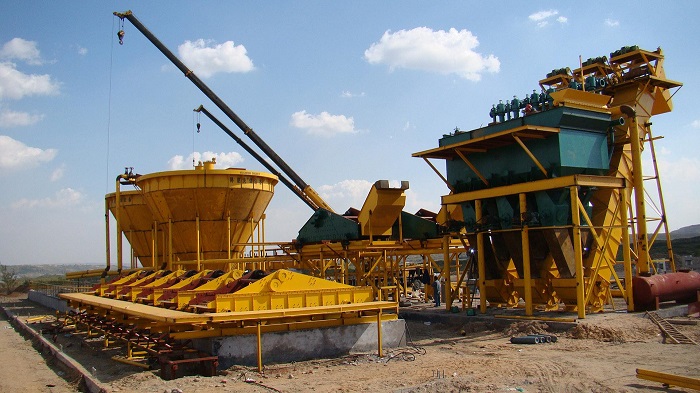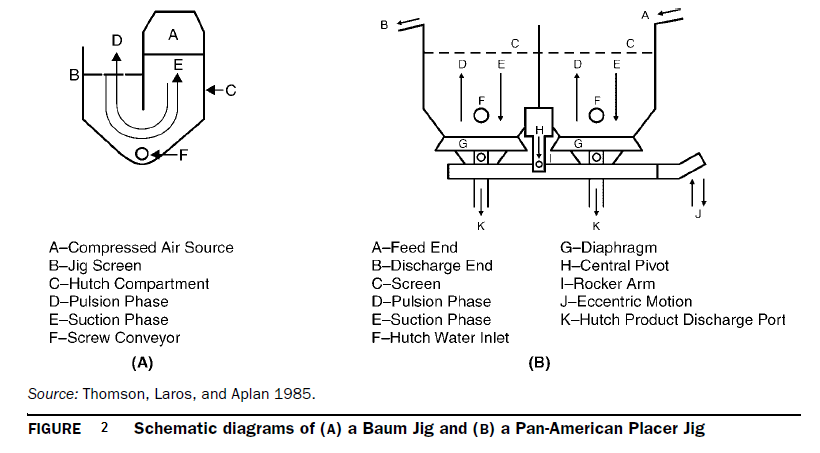Jig is commonly used in gravity separation processing in heavy ores such as gold ore, tin ore, manganese etc.

The essence of a jig is captured in Figure 1, which shows a Harz Jig. The downward movement (called the pulsion stroke) of a plunger fluidizes the bed of particles on a sieve plate so that heavy particles move to the bottom and light particles to the top of the bed. As the plunger then moves upward, it creates a suction stroke that collapses the jig bed.
The capacity of jigs, usually given as tons per square meter of bed area per hour (t/m2/h), is so variable as to be meaningless unless the jig type and conditions are closely specified. Capacity is a function of the jig type and size, the particle size and nature of the feed, the amount of the various products to be removed, and the desired quality and recovery of concentrate.

Jig Types
Jigs were formerly classified as movable (where the bed of particles moved up and down in a tank of static water) and fixed sieve (where the bed is fixed and the water is moved). With but few important commercial exceptions (principally the Remer Jig), nearly all jigs in use today are of the fixed sieve type.
The Remer Jig is composed of an oblong box with a sieve plate bottom that supports the bed of particles being jigged. It is surrounded by a rubber diaphragm that is also attached to the enclosed vat of water in which it sits. One of two longitudinal, eccentric shafts located below the jig compartment supplies the main jigging action; the second supplies a higher frequency action to keep the bed in motion.
Although jigs are not as efficient as HMS, they have much lower capital and operating costs that make them ideal for temporary use or to treat smaller tonnages of relatively coarse material. It is convenient to classify jigs as plunger, pulsator, or full-suction jigs.

Plunger Jigs.
Plunger jigs are typified by variations of the Harz Jig (Figure 1) that provide both a pulsion and a suction stroke. Although many types of these jigs were once used to concentrate ores, they are used today only in special circumstances largely because today’s ores, if coarse, may be more effectively concentrated by HMS. Or, if the ore mineral is disseminated, as is usually the case today, a full-suction jig or some other concentration device will commonly do a superior job. Harz-type jigs operate at 100–300 strokes/min and use a 0.4- to 10-cm stroke length. Today, such jigs are not commonly used, although one specific type, the Denver Mineral Jig, is used in special circumstances. This jig admits water during the upstroke, which lessens the suction somewhat but gives superior capacity.
Pulsion Jigs.
Pulsion jigs were used extensively in the days before the advent of HMS. They resemble a small Harz Jig except that the plunger was replaced by a standpipe about 10-m high with a rotating valve that alternately admitted and shut off water. This action created a pulsion that cyclically fluidized the jig bed while the suction cycle was essentially nonexistent and greatly increased the capacity of the jig. The Richards Pulsator was reported to have a capacity as high as 65 t/m2/h for relatively coarse sulfide ore. Although these examples illustrate the advantages of pulsion, the devices are essentially obsolete for treating ores because of the efficiency of HMS and the dearth of ores liberated at a relatively coarse size.
A closely allied jig used almost exclusively for cleaning coal, the Baum Jig (Figure 2A), also greatly emphasizes the pulsion stroke. It has a U-shaped tank, and pulsion is created by alternately admitting and exhausting compressed air in one leg of the U. This sequence pulses the water and fluidizes thebed (Leonard and Hardinge 1991). Any trace of suction is represented by the absence of pulsion. The water is typically pulsed 60–80 pulses/min. Baum jigs can handle coal up to 130 mm, and at that size they have capacities of about 40 t/m2/h. Jigs with capacities of 270–700 tph are not uncommon. Such jigs are not very efficient for concentrating particles below about 6 mm, but circumstances generally allow the device to work well in practice anyway. Although fines, low ash or not, tend to report to the clean coal product, the fine sizes in many raw coals are mostly particles of coal. Thus, the weight of noncoal fines reporting to the clean coal is typically small. Further, fine clays reporting to the coal product are easily removed when the coal is dewatered, as by screening. As a consequence, a Baum Jig can often be used on a broad feed size without adding much ash to the clean coal product. Next to HMS processes, jigging is the most widely used means of cleaning coal.
Full-suction Jigs.
Full-suction jigs are ordinarily used in treating ores such as placer gravels for the recovery of fine gold, cassiterite, and diamonds. Rather than a separate pulsion compartment, they have a rubber diaphragm in the hutch area, which is located a short distance below the sieve that holds the jig bed (Figure 2B). In this way, the full-suction stroke is transmitted directly to the bed, which greatly facilitates consolidation trickling. The jig thus has both a full-pulsion and a full-suction stroke.
The location of the diaphragm underneath the jig bed favors the use of these jigs on dredges, where space is at a premium, because they require only about half the floor space of a Harz-type jig. Typical jigs of this type are the Cleaveland, IHC-Holland, Pan-American Placer, Ruoss, and Yuba. When treating –13-mm placer gravel, they have a capacity of about 5 t/m2/h. This lower capacity in comparison with some other jigs is related to the full-suction stroke and the small particle size of the valuable mineral to be recovered. Further, the valuable cassiterite contained in the –13 mm placer gravel to be jigged is typically much less than 10 mesh (1.7 mm) in size. Placer jigs do a good job of recovering particles greater than 200 mesh (74 μm), a less effective job from 200 to 400 mesh, and a poor job below 400 mesh (37 μm). The high specific gravity of gold makes its recovery somewhat better than that of other heavy minerals, unless the gold is in flakes. These jigs are typically used to treat lean ore; placer cassiterite ore will contain only about 0.04% cassiterite, and gold and diamond placer gravels will contain very much less.
Placer jigs are rarely used to make a final concentrate in one step. In the recovery of placer cassiterite, for example, rougher, cleaner, and recleaner jigs are used to produce a final heavy-mineralwet concentrate at an overall ratio of concentration of about 1,000:1. The cassiterite is then removed from the other heavy minerals in a “dry” plant using magnetic, electrostatic, and gravity methods.

Ragging.
Where other jigs typically remove most of the heavy particles from the bed, usually by a downcomer and dam arrangement (see Figure 1), the placer jig recovers most of the valuable material through the jig sieve and into the hutch. Accordingly, to prevent much of the fine material from flowing directly into the hutch, ragging must be used. The ragging consists of about three layers of particles having a specific gravity similar to that of the heaviest particles being jigged. Hence, steel shot (ρ = 7.8) is used for many ores, hematite (ρ = 5.0) for cassiterite, and feldspar (ρ = 2.56) for raw coal. In many jigging operations, the heavy constituent in the ore being jigged will quickly accumulate during operation and serve as the ragging. However, when the material to be jigged lacks relatively coarse heavy minerals, artificial ragging is required.